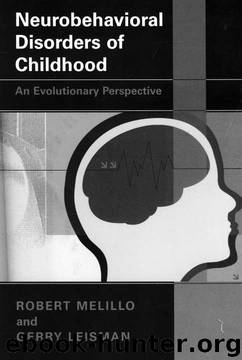Neurobehavioral Disorders of Childhood: An Evolutionary Perspective by Robert Melillo;Gerry Leisman

Author:Robert Melillo;Gerry Leisman [Leisman, Robert Melillo;Gerry]
Language: eng
Format: epub
Published: 2008-05-17T06:24:00+00:00
CORTICAL-SUBCORTICAL CIRCUITS
AND AFFECTIVE DISORDERS
In considering how cerebellar, thalamic, or basal ganglionic dysfunction may lead to depression or mania, it has been proposed that it is the result of the disruption of frontal cortical function. The caudate is thought to share common pathways with frontal cortical structures either directly or through the dorsomedial nucleus of the thalamus. Alexander and colleagues (1986) described five functionally segregated parallel frontal cortical- striatal-thalamic loops, both motor and non-motor with variable degrees of limbic input. Part of the non-motor loop, a dorsolateral prefrontal network would be used for storage in working memory of spatial locations (Goldman-Rakic, 1987). A lateral orbito-frontal circuit, proceeding from the orbito-frontal cortex to a specific area of the caudate and globus pallidus would then project to the thalamus and the orbito-frontal cortex again. This loop is thought to be responsible for learning and recognition tasks requiring frequent shifts of set. This interpretation is thought to explain the pronounced perseveration seen in orbito frontal damage. In addition, there is an anterior cingulate circuit, which includes the ventral striatum, nucleus accumbens, and medio-dorsal nucleus of the thalamus. The hippocampus and entorhinal cortex also send information in this loop integrating information from the para-limbic association cortex. It is thought that the nucleus accumbens is a target of dopaminergic terminals from the mesencephalic ventro-tegmental area (VTA).
Mayberry (1992) conducted PET studies of basal ganglia stroke patients. They found that compared to euthymic patients, all of the patients with mood change showed hypometabolism in the orbital-inferior frontal cortex, anterior temporal cortex, and cingulate cortex. Of course the cerebellum could be considered a primary source of many of these findings as well. Recent reports on human emotional behavior show that disorders in control of affect can follow atrophy of the midline cerebellum (Gutzmann and Kuhl, 1987). Lack of behavioral self-control, including episodic rage, is sometimes seen as an early symptom of tumor of the paleo-cerebe!- lum (Elliot, 1982). It has been reported that after the surgical removal of a benign tumor, several weeks of explosive behavior follow. The cerebellum is connected to the neocortex and the limbic system. One route connects the cerebellum to the thalamus and the cerebral neo-cortex. The other route connects the cerebellum to the hypothalamus and therefore to older structures of the brain (Haines et al., 1984, 1990; Haines and Dietricks, 1987; Dietricks and Haines, 1989). It is thought that the midline paleo-cerebellum is connected primarily to the limbic system and limbic neocortex, whereas the lateral cerebellum is more connected to the neo-cortex especially the prefrontal cortex. It has been noted that a large percentage of children with learning disabilities and affective disorders like ADHD present with motor deficits that are consistent with cerebellar and or basal ganglia dysfunction.
Download
This site does not store any files on its server. We only index and link to content provided by other sites. Please contact the content providers to delete copyright contents if any and email us, we'll remove relevant links or contents immediately.
When Breath Becomes Air by Paul Kalanithi(7280)
Why We Sleep: Unlocking the Power of Sleep and Dreams by Matthew Walker(5668)
Paper Towns by Green John(4179)
The Immortal Life of Henrietta Lacks by Rebecca Skloot(3835)
The Sports Rules Book by Human Kinetics(3602)
Dynamic Alignment Through Imagery by Eric Franklin(3505)
ACSM's Complete Guide to Fitness & Health by ACSM(3476)
Kaplan MCAT Organic Chemistry Review: Created for MCAT 2015 (Kaplan Test Prep) by Kaplan(3431)
Introduction to Kinesiology by Shirl J. Hoffman(3308)
Livewired by David Eagleman(3140)
The River of Consciousness by Oliver Sacks(3001)
Alchemy and Alchemists by C. J. S. Thompson(2918)
The Death of the Heart by Elizabeth Bowen(2912)
Descartes' Error by Antonio Damasio(2749)
Bad Pharma by Ben Goldacre(2738)
The Gene: An Intimate History by Siddhartha Mukherjee(2502)
Kaplan MCAT Behavioral Sciences Review: Created for MCAT 2015 (Kaplan Test Prep) by Kaplan(2495)
The Fate of Rome: Climate, Disease, and the End of an Empire (The Princeton History of the Ancient World) by Kyle Harper(2445)
The Emperor of All Maladies: A Biography of Cancer by Siddhartha Mukherjee(2440)
